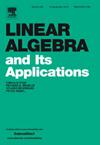下网格和上网格测试集的代数注释
IF 1.1
3区 数学
Q1 MATHEMATICS
引用次数: 0
摘要
对于给定的k[x1,…,xn]的有限维子空间P,其中k是一个域,则N的任何元素在N的所有点处消失,且在kn上全部消失,则N的一个子空间N是一个P检验集;如果N在所有p检验集中具有最小的基数,我们就说它是最优的。我们考虑这个插值问题的一个一般版本,当P有一个单项式基B,我们用一个网格(即N0n的有限子集)来标识,每个节点是一个自变量的N元组,节点集用一个网格C≠N0n来标识。我们的主要结果的一个推论为B=C是σ-下(或σ-上)格时对应的一般插值问题的线性系统的行列式提供了一个显式公式,其中我们说B是σ-下(resp)格。, σ-上)网格,如果它是以σ为公共原点的no0n区间的并集。端点)。我们给出了由σ-下(或σ-上)网格决定的单基空间的显式(最优)p检验集。最后的推论,对于有限域的情况,在数论和编码理论中有潜在的用途。本文章由计算机程序翻译,如有差异,请以英文原文为准。
Algebraic notes on testing sets for lower and upper grids
For a given finite dimensional subspace of , where k is a field, a subset is a -testing set if any member of that vanishes at all points of , vanishes all over ; and we say is optimal if it has the smallest cardinality among all -testing sets. This is related to Lagrangian interpolation of data on a set of nodes using functions from . We consider a generic version of this interpolation problem, when has a monomial basis that we identify with a grid (i.e. a finite subset of ), each node is an n-tuple of independent variables and the set of nodes is identified with a grid . A corollary to our main result offers an explicit formula for the determinant of the linear system corresponding to the generic interpolation problem in case is a σ-lower (or σ-upper) grid, where we say is a σ-lower (resp., σ-upper) grid if it is a union of intervals of having σ as common origin (resp., endpoint). We give explicit (optimal) -testing sets for spaces having monomial bases determined by σ-lower (or σ-upper) grids. The corollaries at the end, for the finite field case, have potential use in Number Theory and Coding Theory.
求助全文
通过发布文献求助,成功后即可免费获取论文全文。
去求助
来源期刊
CiteScore
2.20
自引率
9.10%
发文量
333
审稿时长
13.8 months
期刊介绍:
Linear Algebra and its Applications publishes articles that contribute new information or new insights to matrix theory and finite dimensional linear algebra in their algebraic, arithmetic, combinatorial, geometric, or numerical aspects. It also publishes articles that give significant applications of matrix theory or linear algebra to other branches of mathematics and to other sciences. Articles that provide new information or perspectives on the historical development of matrix theory and linear algebra are also welcome. Expository articles which can serve as an introduction to a subject for workers in related areas and which bring one to the frontiers of research are encouraged. Reviews of books are published occasionally as are conference reports that provide an historical record of major meetings on matrix theory and linear algebra.

 求助内容:
求助内容: 应助结果提醒方式:
应助结果提醒方式:


